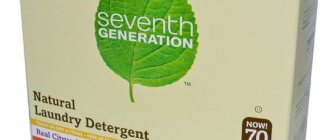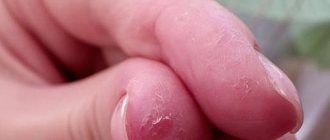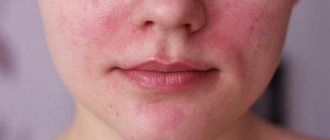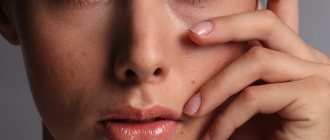Causes
At the base of the nail, where the growth zone is located, there is a special fold of skin called the cuticle. It plays a protective role, and therefore should be denser than the surrounding epithelium. If it dries out and other areas around the nail become rough, then you have to look for the source of such changes. And the reasons may be the following:
- The influence of hot, hard and chlorinated water.
- Contact with chemical compounds and allergens.
- Permanent mechanical damage.
- Cold and dry air.
- Allergic reactions.
- Deficiency of vitamins and minerals.
- Wrong manicure.
- Poor hand skin care.
As you can see, dry skin around the nails appears due to external or internal factors that negatively affect the epithelium. As a result of chemical, mechanical, thermal or metabolic influence, the formation of keratinized epidermal cells is stimulated. In fact, this can become a kind of protective reaction to increase nonspecific skin resistance.
Why the skin around the nails is very dry can be determined after analyzing the external and internal factors affecting the epithelium.
Causes of cracked skin around fingernails
The main mechanism for the appearance of dryness near the nail plates is dehydration of the epidermis. The consequence of this process is cracks and bleeding. The main reasons leading to moisture deficiency in cells are as follows:
- Temperature changes, to which the skin on the fingers is very sensitive. For some people, the epidermis cracks and peels in frosty weather. Symptoms often resemble an allergic reaction, because sometimes they appear instantly. In this case, a special approach and special protective and nutritional agents are required.
- Using cosmetics that are not suitable for the skin on your hands. The choice of care products must be taken seriously. If they are chosen incorrectly or made from low-quality ingredients, the surface of the fingers will peel and crack even more.
- Using household chemicals without protective gloves. Detergents for cleaning rooms, washing dishes and laundry contain many aggressive substances aimed at combating stains. Therefore, they have a negative effect on the layers of the epidermis, which is manifested by dryness and flaking. It is not recommended to wash your hands with soap often, but only when necessary. It is known that an alkaline environment dehydrates tissue, which is manifested by a feeling of tightness and a tendency to peeling.
- Vitamin deficiency with insufficient intake of vitamins A, E, B, Omega-3 and magnesium into the body creates favorable conditions for the appearance of cracks.
- Fungi or diseases not associated with infectious agents (eczema, psoriasis). The skin around the nail becomes dry, scaly and sometimes cracks if treatment is not started in time.
- Diseases of internal organs (gastritis, diabetes, hypothyroidism, depression, VSD). Often they are accompanied by skin problems in the form of dryness and flaking.
- Infection of the body with parasites leads to an allergic reaction. The skin begins to itch, and certain areas on the toes and hands crack. In treatment, it is important to destroy helminths, which will subsequently alleviate skin manifestations.
If the hardening is not associated with infection, then in the initial stages you can treat yourself using homemade remedies.
Preventive measures
It is known that it is always easier to prevent a problem than to deal with it in the future. To ensure that the skin under and around your nails is always healthy and well-groomed, you must follow the following recommendations:
- Wear gloves when going outside in winter.
- Protect skin from detergents and other chemicals.
- Use liquid soap with added gel.
- Avoid using rough scrubs.
- Massage your hands with vegetable oil (olive or other).
- Eat well.
- Contact a dermatologist promptly if problems arise.
A special role is given to proper care of nails and skin of the hands. It is recommended not to remove the cuticle with nail scissors, but to push it to the base. Before this, it is recommended to steam your hands in a bath with added oils.
By minimizing or eliminating the influence of negative factors, it is possible to avoid negative consequences for the epidermis. As a result, there is no need to talk about dryness, and the skin of your hands will remain beautiful and healthy.
How to fix the problem
Masks
Creams and ointments from the pharmacy that include vitamin E will help you cope with peeling skin near your fingers. The most effective remedies include Radevit, Bepanten, and D-Panthenol. Actovegin will help cope with deep cracks; it deeply moisturizes and nourishes the area around the fingernails.
A more budget-friendly mask can be made yourself at home from two tablespoons of glycerin and one spoon of honey. To thicken the mass, add a teaspoon of flour, then apply to the area around the nails and wait 20 minutes, then rinse.
Vegetable oils sold in the same pharmacy will help restore the skin and moisturize the cuticle, as they are saturated with vitamins A, E and other components important for the epidermis. As oils you can take almond oil, wheat germ oil, shea butter and argan oil. To get more effect, you need to mix them in equal proportions and apply to problem areas for half an hour, then blot off the remaining oil with a dry cloth.
A currently fashionable salon procedure using cosmetic wax will quickly cope with dry skin. To carry it out at home, you need to dip your fingers in cosmetic wax melted in a water bath, wait for it to harden, then put on gloves made of natural material and go to bed, and carefully get rid of the wax in the morning.
Baths
- Starchy. Dilute one teaspoon of starch in 0.5 liters of high temperature water, hold your hands in the mixture for 20-30 minutes, dry your hands and apply moisturizer.
- An aqueous solution of mummy tablets will help relieve itching and burning. The resin included in their composition has incredible healing properties. You need to keep your hands in the bath for about 15 minutes.
Correction methods
If it’s too late to talk about preventive measures, then you’ll have to pay attention to another question: what to do so that the cuticle and skin around the nails are not dry. There are several methods of cosmetic correction for this. It is better to ask a specialist which one is suitable in a particular case.
Peeling
First of all, it is necessary to get rid of the excessive layer of dead cells covering the epithelium. Various scrubs will help with this - both pharmacy and homemade. The latter may include the following components:
- Sugar.
- Sea salt.
- Coffee beans.
- Walnuts.
- Cereals.
There are quite a lot of recipes; scrubbing components are placed in a creamy or gel-like medium, which can be created using sour cream, vegetable oils, and fruit puree. The mixture is applied to the skin around the nail, after which it is massaged in a circular motion.
Peeling is the first component of comprehensive care for dry and rough skin around the nails. Its purpose is to exfoliate dead cells.
Creams
Hand creams will also help soften the skin, saturate it with useful ingredients and reduce negative external influences. For this purpose, pay attention to the following cosmetic products:
- Moisturizing.
- Nutritious.
- Sun protection.
Creams often contain glycerin, essential oils, vitamins, and plant extracts. Some remedies are easy to prepare at home.
Masks
If dry skin around the fingernails has become a real problem, then in a comprehensive correction one cannot help but pay attention to cuticle masks. Both ready-made mixtures and those made independently can be used. As a recipe for such a mask, you can suggest a product made from olive oil, aloe juice and honey. A homogeneous mass is applied to the cuticle twice a week.
Treatment for dry and rough skin
For treatment, a nourishing cream containing hyaluronic acid, which is involved in the process of tissue regeneration, is applied daily to the cuticle and side ridges. To moisturize these areas, products containing glycerin are used.
Once a week, it is recommended to apply a scrub to the nail area to help get rid of dry, dead, rough tissue. After the procedure, the substance is washed off, and a nourishing gel or cream is applied to the treated area; it is possible to use a special cuticle oil.
Also, if the skin around the nails is dry, then to soften it you need to use nourishing baths in the evenings.
Baths
Bath for softening the skin in the photo.
One of the best bath products for peeling skin on the fingers is starch. A tablespoon of the product is diluted in a liter of hot water. Perform for 15 minutes.
It is possible to use crushed potatoes. For the bath, mix it with two glasses of hot water and a glass of milk. Hold your fingers for up to 20 minutes. At the end of the procedure, wipe dry and rub in nourishing cream. After performing such baths, the beauty of your fingers and the health of your skin will be restored quickly.
We also recommend reading: baths for strengthening and growing nails: proven recipes.
Inflammation of the cuticle: causes, symptoms, treatment with pharmacy and home remedies
The cuticle is a roll of skin surrounding the nail. Its function is to exclude the possibility of penetration of bacteria and various particles of foreign origin between the nail plate and the epidermis. With proper care and manicure, problems with the condition of the cuticle do not arise.
But violating the rules of procedures can cause inflammation of the cuticle. The skin around the nail is quite thin and delicate. In addition, it is constantly exposed to environmental influences, comes into contact with various chemicals and receives mechanical damage.
All these factors provoke inflammation of the cuticle, which needs treatment.
Pharmacy products
Pharmacy products are more effective in relieving inflammation and removing ulcers and cuticle redness. Their main task is to relieve the patient from redness and pain. All medications must be prescribed by a specialist. Before purchasing them, it is important to make sure that the cause of the inflammatory process is not an allergic reaction - then the treatment will be different.
Drugs that will help eliminate abscesses with purulent discharge are:
- Vishnevsky ointment. A universal anti-inflammatory agent. Its main task is to remove all the dirt along with pus from the wound, and then allow the cuticle to heal peacefully.
- Ichthyol ointment. Based on it, you can prepare a night compress for the affected area. A small amount of ichthyol ointment is applied to a cotton pad or a piece of cotton folded several times, after which the compress is tightly applied to the inflamed area and secured with an adhesive plaster or a tight bandage. It is better to carry out the procedure in the evening so that the bandage remains in place all night and does not interfere with your usual activities.
If the finger around the nail is swollen, first you need to treat it with a disinfectant and only then proceed to create a compress or bandage for the night.
Treatment at home
Traditional medicine is suitable for treatment at home. A paste based on aloe vera or plantain is good for relieving inflammation. It is also applied to a cotton pad or gauze, after which it is fixed on the affected area and left there overnight.
The pulp can be replaced with fresh shoots of aloe vera or plantain, which have the same effect and are good at drawing out pus. Aloe has excellent healing properties. The plant will not only draw out all the pus from the wound, but will also promote its speedy healing.
A nail bath with soda or various oils will help get rid of itching and redness. The main thing is that the ingredients did not cause an allergic reaction, which could provoke a new wave of inflammation. If there are small cracks and scratches on the cuticle, it is better to avoid using soda, as it can cause irritation and pain.
How to treat inflamed nail cuticles
The cuticle is a roll of skin surrounding the nail. Its function is to exclude the possibility of penetration of bacteria and various particles of foreign origin between the nail plate and the epidermis. With proper care and manicure, problems with the condition of the cuticle do not arise.
But violating the rules of procedures can cause inflammation of the cuticle. The skin around the nail is quite thin and delicate. In addition, it is constantly exposed to environmental influences, comes into contact with various chemicals and receives mechanical damage.
All these factors provoke inflammation of the cuticle, which needs treatment.
Causes of inflammation
The inflammatory process of the cuticle is characterized by redness, swelling, and in severe cases, pus, unpleasant odor and pain.
The reasons that provoke inflammation of the cuticle include:
- Presence of burrs. If you tear them off, process them incorrectly, or do a manicure with non-sterile instruments, then problems are guaranteed.
- Unhealthy cuticle that is too thin or overgrown, dry, flaky, processed with damage to tissue integrity.
- Microorganisms and fungal infections that have entered the tissue.
- Mechanical damage in the form of blows, cuts.
Treatment of inflamed cuticle
Depending on the nature of the cause that caused the inflammation, treatment methods are determined.
Only a doctor can treat a cuticle affected by a fungus, because self-medication may not only worsen the skin condition, but also cause problems with nails. In addition, with a severe infection, a course of antibiotics is sometimes indicated. And any medications can only be taken as prescribed by a doctor.
With flaky cuticles, an important point for treatment is the absence of trimmed manicure. It is after this that the skin dries out and cuts appear, opening access to infections.
The most correct solution is to do a non-edged manicure, in which the cuticle is carefully pushed back with a special stick.
After any nail care procedures or household work, it is necessary to moisturize the skin around the nails with lotions and creams. And do housework exclusively with gloves.
At the first signs of inflammation around the nail, you should thoroughly wash and dry your hands.
If there is pus, it should be removed by light pressure if it is not deep, or compresses should be made using the pulp of aloe leaves to draw it out.
Baths with a strong saline solution (white vinegar, Epsom salts) or the use of special ointments will also help. After removing the pus, the wound is disinfected with hydrogen peroxide, cauterized with iodine and covered with a bandage.
You can treat the cuticle after cleansing from suppuration or with minor inflammation around the nail at home or by contacting a specialist.
Essential oils are the most popular means for caring and treating the skin around the nails. The most effective are grapefruit, apricot and castor oils.
If you do the procedures regularly, the inflammation will go away in a short time, and the nails and skin will become elastic.
To eliminate inflammation and improve the condition of the cuticle you need to:
- Apply lavender oil around the nail area. It is they that are best used to treat inflamed tissues, as it is a powerful antiseptic.
- Apply an ointment consisting of calendula flowers and petroleum jelly. For 0.5 cups of dry matter, take 10 grams of Vaseline. After heating in a water bath, the mixture must be infused for 10-12 hours. Then place in a convenient container, after straining.
- Rub the inside of the grapefruit peel. Thus, the cuticle can not only be disinfected, but also nourished with vitamins.
- To eliminate dying cells, rub cornmeal into wet fingers once every seven days. This natural scrub is great for cleansing.
Very dry cuticle
Cuticles protect our nails and skin from infection. If they are dry and cracked, bacteria can enter the nail bed. Today we'll talk about what to do if you have very dry cuticles and how to avoid it.
How to spot dry cuticles
Your cuticle is a layer of clear skin. They are located at the bottom of your nail, along the nail bed. The cuticle protects our nails by acting as a barrier to bacteria.
The cuticle area is very delicate. It can easily dry out and crack. This occurs most often during the colder months of the year, due to a lack of moisture in the air and exposure to dry heat indoors.
You can tell if your cuticles are dry if they are flaking, cracking, or flaking. This can not only ruin the appearance of your manicure, but is also fraught with health consequences. Cracked and peeling cuticles can allow bacteria to enter the nail bed and cause an infection. Therefore, I highly recommend paying proper attention to your cuticles as soon as you notice dryness.
Why does the cuticle dry out?
Some of the most common causes of dry cuticles include:
- insufficient hydration
- washing your hands too often
- frequent use of hand sanitizers or nail polish remover
- cold weather
- eczema
- malnutrition
- taking certain medications
- habit of biting nails or biting cuticles
While most of the above are not cause for concern, see your doctor if you think eczema is causing your dry cuticles. The doctor will be able to recommend the necessary medications in order to normalize the situation.
Can dry cuticles be harmful to your health?
Dry cuticles usually do not lead to any serious complications. But see a doctor if your cuticles bleed frequently or look infected. Signs of infection may include:
- redness
- swelling
- pain in the area around the cuticle
Your doctor may recommend a stronger moisturizer to help combat dryness. If your cuticles are infected, you may need to take antibiotics.
How to treat dry cuticle
The easiest way to treat dry cuticles is to moisturize the delicate area with a cream or oil. Some treatment options include:
Cuticle cream
Cuticle cream is an emollient that nourishes and moisturizes dry cuticles. It is desirable that the cream you choose contains ingredients such as vitamins A, C and E , as well as natural oils, such as almond or sunflower. Oils will help soften the cuticle, and vitamins will help strengthen and nourish it.
After washing your hands, massage a small amount of cream into the nail bed. You can buy cuticle cream at any pharmacy or cosmetics store.
Cuticle oil
Cuticle oil is the most effective way to soften and moisturize the cuticle area. It is usually a mixture of oils with added vitamins. Cuticle oil absorbs quickly and is great for keeping your nails and skin moisturized and helps prevent future dryness and cracking.
To use cuticle oil, apply a small amount to the nail bed using your fingertip or a soft brush.
As with the cream, you can buy cuticle oil in beauty salons, pharmacies, or specialized cosmetic stores.
Coconut oil
If you're on a budget, coconut oil is an affordable alternative to treating dry cuticles at home. The saturated fat in coconut oil can help soothe and strengthen your nails.
Rub a small amount of coconut oil into each nail using a fingertip or a soft brush several times a day. After just a short amount of time, you will notice that the cuticles have become noticeably softer. The healing properties of coconut oil will also help deal with cracks.
Make your own biotin cuticle ointment
Some research suggests that biotin may help prevent dryness and strengthen cuticles. can be found on sale in powder and liquid form .
Mix biotin with antioxidant-rich vitamin E , moisturizing argan oil and coconut oil for a homemade salve for dry cuticles. Apply the mixture daily, or every other day, for best results.
How to prevent dry cuticles
The easiest way to prevent dry cuticles is to moisturize your hands frequently. This is especially true in the winter months. Apply lotion or cream after each hand wash.
Avoid any products with harsh chemicals that can dry out your cuticles, such as:
- Hard soap
- Hand sanitizers
- Nail polish remover
- Household chemicals
We very often underestimate the importance of the cuticle for the health and beauty of our nails. I hope after reading my article today you will pay close attention to ways to moisturize the cuticle. Be healthy and beautiful!
Source: https://pilochka.ua/ochen-suxaya-kutikula/











